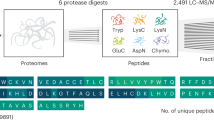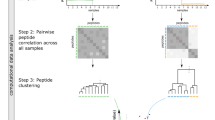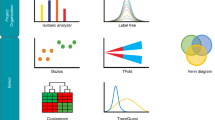Abstract
The long-term challenge of proteomics is enormous: to define the identities, quantities, structures and functions of complete complements of proteins, and to characterize how these properties vary in different cellular contexts. One critical step in tackling this goal is the generation of sets of clones that express a representative of each protein of a proteome in a useful format, followed by the analysis of these sets on a genome-wide basis. Such studies enable genetic, biochemical and cell biological technologies to be applied on a systematic level, leading to the assignment of biochemical activities, the construction of protein arrays, the identification of interactions, and the localization of proteins within cellular compartments.
This is a preview of subscription content, access via your institution
Access options
Subscribe to this journal
Receive 51 print issues and online access
$199.00 per year
only $3.90 per issue
Buy this article
- Purchase on Springer Link
- Instant access to full article PDF
Prices may be subject to local taxes which are calculated during checkout



Similar content being viewed by others
References
Kenyon, G. L. et al. Defining the mandate of proteomics in the post-genomics era. Workshop Report: National Academy of Sciences, Washington DC, USA. Mol. Cell. Proteomics 1, 763–780 (2002).
Cliften, P. F. et al. Surveying Saccharomyces genomes to identify functional elements by comparative DNA sequence analysis. Genome Res. 11, 1175–1186 (2001).
Kumar, A. et al. An integrated approach for finding overlooked genes in yeast. Nature Biotechnol. 20, 58–63 (2002).
Hudson, J. R. Jr et al. The complete set of predicted genes from Saccharomyces cerevisiae in a readily usable form. Genome Res. 7, 1169–1173 (1997).
Reboul, J. et al. Open-reading-frame sequence tags (OSTs) support the existence of at least 17,300 genes in C. elegans. Nature Genet. 27, 332–336 (2001).
Braun, P. et al. Proteome-scale purification of human proteins from bacteria. Proc. Natl Acad. Sci. USA 99, 2654–2659 (2002).
Nilsson, J., Stahl, S., Lundeberg, J., Uhlen, M. & Nygren, P. A. Affinity fusion strategies for detection, purification, and immobilization of recombinant proteins. Protein Exp. Purif. 11, 1–16 (1997).
Zhu, H. et al. Global analysis of protein activities using proteome chips. Science 293, 2101–2105 (2001).
Martzen, M. R. et al. A biochemical genomics approach for identifying genes by the activity of their products. Science 286, 1153–1155 (1999).
Xing, F., Martzen, M. R. & Phizicky, E. M. A conserved family of Saccharomyces cerevisiae synthases effects dihydrouridine modification of tRNA. RNA 8, 370–381 (2002).
Alexandrov, A. V., Martzen, M. R. & Phizicky, E. M. Two proteins that form a complex are required for 7-methylguanosine modification of yeast tRNA. RNA 8, 1253–1266 (2002).
Hazbun, T. R. & Fields, S. A genome-wide screen for site-specific DNA-binding proteins. Mol. Cell. Proteomics 1, 538–543 (2002).
Phizicky, E. M. et al. Biochemical genomics approach to map activities to genes. Methods Enzymol. 350, 546–559 (2002).
Grayhack, E. J. & Phizicky, E. M. Genomic analysis of biochemical function. Curr. Opin. Chem. Biol. 5, 34–39 (2001).
MacBeath, G. & Schreiber, S. L. Printing proteins as microarrays for high-throughput function determination. Science 289, 1760–1763 (2000).
Zhu, H. et al. Analysis of yeast protein kinases using protein chips. Nature Genet. 26, 283–289 (2000).
Haab, B. B., Dunham, M. J. & Brown, P. O. Protein microarrays for highly parallel detection and quantitation of specific proteins and antibodies in complex solutions. Genome Biol. 2, RESEARCH0004.1–0004.13 (2001).
Zhu, H. & Snyder, M. Protein arrays and microarrays. Curr. Opin. Chem. Biol. 5, 40–45 (2001).
Weng, S. et al. Generating addressable protein microarrays with PROfusion covalent mRNA- protein fusion technology. Proteomics 2, 48–57 (2002).
Templin, M. F. et al. Protein microarray technology. Trends Biotechnol. 20, 160–166 (2002).
Myszka, D. G. & Rich, R. L. Implementing surface plasmon resonance biosensors in drug discovery. Pharmacol. Sci. Technol. Today 3, 310–317 (2000).
Houseman, B. T., Huh, J. H., Kron, S. J. & Mrksich, M. Peptide chips for the quantitative evaluation of protein kinase activity. Nature Biotechnol. 20, 270–274 (2002).
LeProust, E. et al. Digital light-directed synthesis. A microarray platform that permits rapid reaction optimization on a combinatorial basis. J. Comb. Chem. 2, 349–354 (2000).
Wang, D., Liu, S., Trummer, B. J., Deng, C. & Wang, A. Carbohydrate microarrays for the recognition of cross-reactive molecular markers of microbes and host cells. Nature Biotechnol. 20, 275–281 (2002).
Kuruvilla, F. G., Shamji, A. F., Sternson, S. M., Hergenrother, P. J. & Schreiber, S. L. Dissecting glucose signalling with diversity-oriented synthesis and small-molecule microarrays. Nature 416, 653–657 (2002).
Sreekumar, A. et al. Profiling of cancer cells using protein microarrays: discovery of novel radiation-regulated proteins. Cancer Res. 61, 7585–7593 (2001).
Belov, L., de la Vega, O., dos Remedios, C. G., Mulligan, S. P. & Christopherson, R. I. Immunophenotyping of leukemias using a cluster of differentiation antibody microarray. Cancer Res. 61, 4483–4489 (2001).
Joos, T. O. et al. A microarray enzyme-linked immunosorbent assay for autoimmune diagnostics. Electrophoresis 21, 2641–2650 (2000).
Robinson, W. H. et al. Autoantigen microarrays for multiplex characterization of autoantibody responses. Nature Med. 8, 295–301 (2002).
Lee, T. I. et al. Transcriptional regulatory networks in Saccharomyces cerevisiae. Science 298, 799–804 (2002).
Faleiro, L., Kobayashi, R., Fearnhead, H. & Lazebnik, Y. Multiple species of CPP32 and Mch2 are the major active caspases present in apoptotic cells. EMBO J. 16, 2271–2281 (1997).
Cravatt, B. F. & Sorensen, E. J. Chemical strategies for the global analysis of protein function. Curr. Opin. Chem. Biol. 4, 663–668 (2000).
Adam, G. C., Sorensen, E. J. & Cravatt, B. F. Chemical strategies for functional proteomics. Mol. Cell. Proteomics 1, 781–790 (2002).
Martins, L. M. et al. Activation of multiple interleukin-1β converting enzyme homologues in cytosol and nuclei of HL-60 cells during etoposide-induced apoptosis. J. Biol. Chem. 272, 7421–7430 (1997).
Greenbaum, D., Medzihradszky, K. F., Burlingame, A. & Bogyo, M. Epoxide electrophiles as activity-dependent cysteine protease profiling and discovery tools. Chem. Biol. 7, 569–581 (2000).
Liu, Y., Patricelli, M. P. & Cravatt, B. F. Activity-based protein profiling: the serine hydrolases. Proc. Natl Acad. Sci. USA 96, 14694–14699 (1999).
Kidd, D., Liu, Y. & Cravatt, B. F. Profiling serine hydrolase activities in complex proteomes. Biochemistry 40, 4005–4015 (2001).
Greenbaum, D. et al. Chemical approaches for functionally probing the proteome. Mol. Cell. Proteomics 1, 60–68 (2002).
Adam, G. C., Sorensen, E. J. & Cravatt, B. F. Proteomic profiling of mechanistically distinct enzyme classes using a common chemotype. Nature Biotech. 20, 805–809 (2002).
Jessani, N., Liu, Y., Humphrey, M. & Cravatt, B. F. Enzyme activity profiles of the secreted and membrane proteome that depict cancer cell invasiveness. Proc. Natl Acad. Sci. USA 99, 10335–10340 (2002).
Bishop, A. C. et al. A chemical switch for inhibitor-sensitive alleles of any protein kinase. Nature 407, 395–401 (2000).
Habelhah, H. et al. Identification of new JNK substrate using ATP pocket mutant JNK and a corresponding ATP analogue. J. Biol. Chem. 276, 18090–18095 (2001).
Bishop, A. C., Buzko, O. & Shokat, K. M. Magic bullets for protein kinases. Trends Cell Biol. 11, 167–172 (2001).
Ho, Y. et al. Systematic identification of protein complexes in Saccharomyces cerevisiae by mass spectrometry. Nature 415, 180–183 (2002).
Gavin, A. C. et al. Functional organization of the yeast proteome by systematic analysis of protein complexes. Nature 415, 141–147 (2002).
Fields, S. & Song, O. A novel genetic system to detect protein–protein interactions. Nature 340, 245–246 (1989).
Fromont-Racine, M. et al. Genome-wide protein interaction screens reveal functional networks involving Sm-like proteins. Yeast 17, 95–110 (2000).
Uetz, P. et al. A comprehensive analysis of protein–protein interactions in Saccharomyces cerevisiae. Nature 403, 623–627 (2000).
Ito, T. et al. A comprehensive two-hybrid analysis to explore the yeast protein interactome. Proc. Natl Acad. Sci. USA 98, 4569–4574 (2001).
Rain, J. C. et al. The protein–protein interaction map of Helicobacter pylori. Nature 409, 211–215 (2001).
Walhout, A. J. M. et al. Protein interaction mapping in C. elegans using proteins involved in vulval development. Science 287, 116–122 (2000).
Mrowka, R., Patzak, A. & Herzel, H. Is there a bias in proteome research? Genome Res. 11, 1971–1973 (2001).
Deane, C. M., Salwinski, L., Xenarios, I. & Eisenberg, D. Protein interactions: two methods for assessment of the reliability of high throughput observations. Mol. Cell. Proteomics 1, 349–356 (2002).
Jansen, R., Greenbaum, D. & Gerstein, M. Relating whole-genome expression data with protein-protein interactions. Genome Res. 12, 37–46 (2002).
Kemmeren, P. et al. Protein interaction verification and functional annotation by integrated analysis of genome-scale data. Mol. Cell 9, 1133–1143 (2002).
von Mering, C. et al. Comparative assessment of large-scale data sets of protein–protein interactions. Nature 417, 399–403 (2002).
Edwards, A. et al. Bridging structural biology and genomics: assessing protein interaction data with known complexes. Trends Genet. 18, 529–536 (2002).
Fashena, S. J., Serebriiskii, I. & Golemis, E. A. The continued evolution of two-hybrid screening approaches in yeast: how to outwit different preys with different baits. Gene 250, 1–14 (2000).
Wouters, F. S., Verveer, P. J. & Bastiaens, P. I. H. Imaging biochemistry inside cells. Trends Cell Biol. 11, 203–211 (2001).
Tsien, R. Y. The green fluorescent protein. Annu. Rev. Biochem. 67, 509–544 (1998).
Siegel, R. M. et al. Fas preassociation required for apoptosis signaling and dominant inhibition by pathogenic mutations. Science 288, 2354–2357 (2000).
Mahajan, N. et al. Bcl-2 and Bax interactions in mitochondria probed with green fluorescent protein and fluorescence resonance energy transfer. Nature Biotechnol. 16, 547–552 (1998).
Day, R. N. Visualization of Pit-1 transcription factor interactions in the living cell nucleus by fluorescence resonance energy transfer microscopy. Mol. Endocrinol. 12, 1410–1419 (1998).
Sorkin, A., McClure, M., Huang, F. & Carter, R. Interaction of EGF receptor and Grb2 in living cells visualized by fluorescence resonance energy transfer (FRET) microscopy. Curr. Biol. 10, 1395–1398 (2000).
Llopis, J. et al. Ligand-dependent interactions of coactivators steroid receptor coactivator-1 and peroxisome proliferator-activated receptor binding protein with nuclear hormone receptors can be imaged in live cells and are required for transcription. Proc. Natl Acad. Sci. USA 97, 4363–4368 (2000).
Kumar, A. et al. Subcellular localization of the yeast proteome. Genes Dev. 16, 707–719 (2002).
Ding, D. Q. et al. Large-scale screening of intracellular protein localization in living fission yeast cells by the use of a GFP-fusion genomic DNA library. Genes Cells 5, 169–190 (2000).
Sawin, K. E. & Nurse, P. Identification of fission yeast nuclear markers using random polypeptide fusion with green fluorescent protein. Proc. Natl Acad. Sci. USA 94, 15146–15151 (1996).
Morin, X., Daneman, R., Zavortink, M. & Chia, W. A protein trap strategy to detect GFP-tagged proteins expressed from their endogenous loci in Drosophila. Proc. Natl Acad. Sci. USA 98, 15050–15055 (2001).
Simpson, J. C., Wellenreuther, R., Poustka, A., Pepperkok, R. & Wiemann, S. Systematic subcellular localisation of novel proteins identified by large-scale cDNA sequencing. EMBO Rep. 1, 287–292 (2000).
Ziauddin, J. & Sabatini, D. M. Microarrays of cells expressing defined cDNAs. Nature 411, 107–110 (2001).
Aslanidis, C. & de Jong, P. J. Ligation-independent cloning of PCR products (LIC-PCR). Nucleic Acids Res. 18, 6069–6074 (1990).
Aslanidis, C., de Jong, P. J. & Schmitz, G. Minimal length requirement of the single-stranded tails for ligation-independent cloning (LIC) of PCR products. PCR Methods Appl. 4, 172–177 (1994).
Dieckman, L., Gu, M., Stols, L., Donnelly, M. I. & Collart, F. R. High throughput methods for gene cloning and expression. Protein Exp. Purif. 25, 1–7 (2002).
Rigaut, G. et al. A generic protein purification method for protein complex characterization and proteome exploration. Nature Biotechnol. 17, 1030–1032 (1999).
Kapust, R. B. & Waugh, D. S. Escherichia coli maltose-binding protein is uncommonly effective at promoting the solubility of polypeptides to which it is fused. Protein Sci. 8, 1668–1674 (1999).
Acknowledgements
We thank T. Davis and E. Grayhack for comments on the manuscript. This work was supported by grants from the National Center for Research Resources and National Human Genome Research Institute of the National Institutes of Health. S.F. is an investigator of the Howard Hughes Medical Institute.
Author information
Authors and Affiliations
Rights and permissions
About this article
Cite this article
Phizicky, E., Bastiaens, P., Zhu, H. et al. Protein analysis on a proteomic scale. Nature 422, 208–215 (2003). https://doi.org/10.1038/nature01512
Issue Date:
DOI: https://doi.org/10.1038/nature01512
This article is cited by
-
Acyl carrier protein tag can enhance tobacco etch virus protease stability and promote its covalent immobilisation
Applied Microbiology and Biotechnology (2023)
-
In silico prediction methods of self-interacting proteins: an empirical and academic survey
Frontiers of Computer Science (2023)
-
Recent Advances in Nano-Bio-Sensing Fabrication Technology for the Detection of Oral Cancer
Molecular Biotechnology (2021)
-
Maternal proteomic profiling reveals alterations in lipid metabolism in late-onset fetal growth restriction
Scientific Reports (2020)
-
An ultra-high-density protein microarray for high throughput single-tier serological detection of Lyme disease
Scientific Reports (2020)
Comments
By submitting a comment you agree to abide by our Terms and Community Guidelines. If you find something abusive or that does not comply with our terms or guidelines please flag it as inappropriate.



